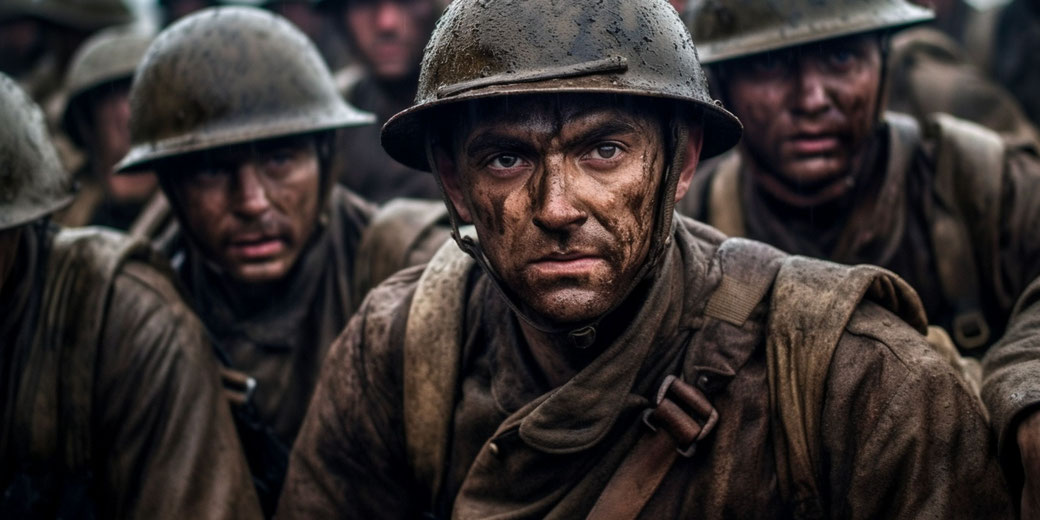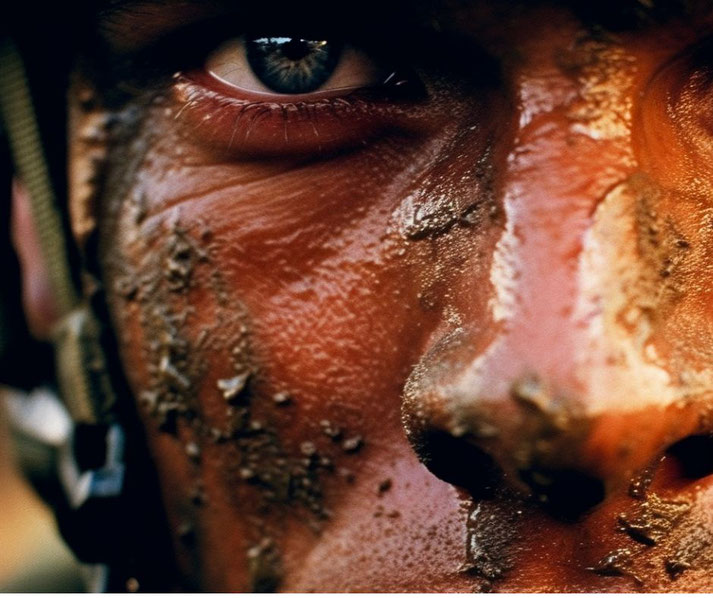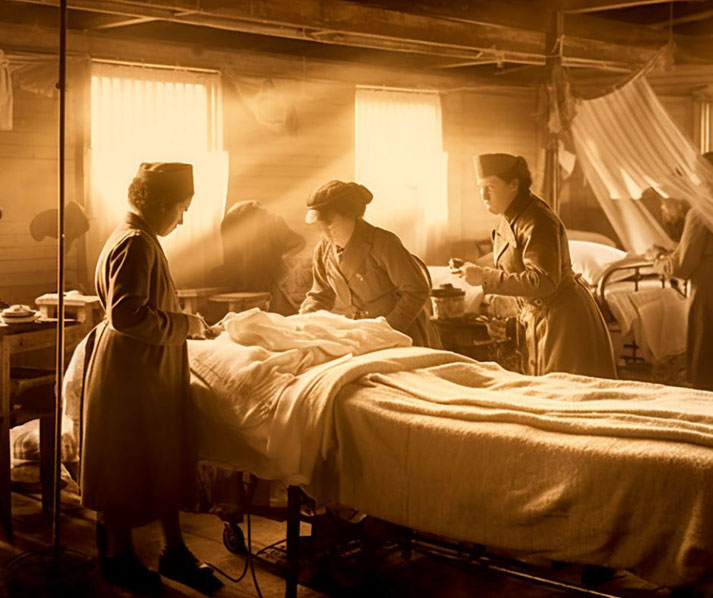Shell Shock: The psychological scourge of WWI

One of the most tragic and lasting legacies of the First World War was the phenomenon of shell shock. This term, coined during the war, descried a range of symptoms exhibited by soldiers exposed to the horrors of trench warfare, including disorientation, tremors, and emotional numbness.
While the phenomenon was not entirely new, since war-induced psychological trauma had been observed in previous conflicts, it was the sheer scale and intensity of World War I that suddenly brought it into sharp focus.
What is shell shock?
Shell shock is a word that originated during World War I to describe the type of post-traumatic stress disorder (PTSD) that many soldiers experienced during the war, before PTSD was officially recognized.
Often, it was an involuntary nervous reaction to the intensity of the artillery bombardment and fighting that produced a deep sense helplessness in the soldiers.
It actually could manifest in many different ways, depending on the individual: as panic, fear, flight, or an inability to reason, sleep, walk, or talk.
In fact, shell shock became one of the major side effects of WWI. Many soldiers suffered from it.
For troops in the trenches, when they suffered from shell shock, they struggled with sleep.
When awake, they panicked on hearing gunshots, loud noises, or shouting.

What caused shell shock?
The war, which lasted from July 28, 1914, to November 11, 1918, was unlike any that had come before it.
The advent of devastating new technologies like machine guns, tanks, and chemical warfare created a level of destruction and carnage that was unprecedented.
Soldiers who were subjected to prolonged periods of bombardment and the constant threat of death, led to extreme psychological stress.
The term "shell shock" was first used in an article by Charles Myers published in The Lancet in 1915.
Myers was a psychologist and army captain. He took the time to describe cases of British soldiers who had been close to exploding shells and exhibited symptoms like tremors, disorientation, and fatigue.
However, the initial understanding of shell shock was limited and often misguided.
Early on, it was commonly believed that the condition was caused by the physical impact of blasts on the brain.
This notion was supported by the fact that many of the men displaying symptoms had been in proximity to high-explosive shells.
But as the war progressed, it became evident that men who had not been near explosions were also presenting with similar symptoms.
By 1916, during the Battle of the Somme, one of the bloodiest conflicts in human history, the British Army alone had over 16,000 reported cases of shell shock.
This led to a shift in perception, and medical professionals began to consider that the condition might be psychological rather than purely physical.
How was shell shock treated?
Unfortunately, the military's initial response to shell shock was complicated by the prevailing attitudes of the time.
Stoicism and bravery were highly valued characteristics in male soldiers, and the growing psychological symptoms were often seen as a sign of weakness or cowardice.
This led to a range of treatments that varied widely in their effectiveness and ethicality.
Some soldiers were subjected to disciplinary action, including court-martial and even execution for "cowardice" or "desertion."
Others were sent to specialized hospitals where they received treatments ranging from psychotherapy to electroshock therapy.
In particular, the War Office in Britain established the first specialized treatment center for shell shock in 1916.
This at least acknowledging the scale of the problem.
These facilities employed a range of treatments, from psychotherapy and hypnosis to more experimental methods like "abreaction," where patients were encouraged to relive traumatic experiences in a controlled setting.
The aim was to help soldiers confront and process their trauma, although the effectiveness of these treatments was a subject of debate.
The medical community was divided on how to approach shell shock, and this division often had significant consequences for the soldiers involved.
Some doctors advocated for a compassionate approach, recognizing that the soldiers were victims of extraordinary circumstances.
Others, influenced by the prevailing social and military mores, viewed shell shock as a sign of weakness or moral failing.

Well-known victims of shell shock
The stories of individual soldiers who experienced shell shock during World War I offer a deeply personal lens through which to understand the phenomenon.
One such case is that of Siegfried Sassoon. Sassoon was a British officer and poet who was diagnosed with shell shock and sent to Craiglockhart War Hospital in Scotland.
There, he met Dr. W.H.R. Rivers, a pioneering psychiatrist who employed "talking cures" and encouraged Sassoon to channel his experiences into his writing.
As a result, Sassoon's poetry has since become emblematic of the complexities of shell shock: forever capturing both the trauma of the trenches and the nascent field of military psychiatry.
Another poignant case is that of Harry Farr, a British private who was executed for cowardice in 1916 after displaying symptoms.
Farr had been hospitalized for shell shock earlier in the war but was sent back to the front lines despite his condition.
His execution was a source of controversy and public debate, and it wasn't until 2006 that he was officially pardoned, along with 305 other British soldiers executed for similar reasons.
The case of Harry Farr serves as a grim reminder of the very real consequences it could have for affected soldiers.
A painful legacy
Shell shock also impacted the families and communities to which the soldiers returned.
The "invisible wounds" carried by these men were not as readily understood or accepted as physical injuries.
Families struggled to understand the changes in their loved ones, and communities were often ill-equipped to provide the necessary support or medical care.
This led to a reevaluation of what constituted a "war hero". As men who had served their countries but were suffering from psychological trauma, they found themselves marginalized or misunderstood.
Public opinion began to shift gradually as the scale of the problem became more apparent.
Organizations like the Red Cross and various veterans' groups played a role in raising awareness and pushing for better treatment options.
By the end of the war and in the years that followed, there was a growing recognition that the psychological scars of battle were as real and as deserving of attention as physical injuries.
As the war drew to a close and in the years that followed, the term "shell shock" gradually fell out of favor, replaced by more nuanced understandings of psychological trauma.
The American Psychopathological Association, in 1919, introduced the term "war neuroses" to describe similar symptoms.
By the time of the Second World War, the U.S. military was using the term "combat stress reaction" to describe acute behavioral disorganization seen in combatants.
This paved the way for the modern understanding of Post-Traumatic Stress Disorder (PTSD), a term that was officially recognized in 1980 by the American Psychiatric Association in the third edition of the Diagnostic and Statistical Manual of Mental Disorders (DSM-III).
What do you need help with?
Download ready-to-use digital learning resources
Copyright © History Skills 2014-2024.
Contact via email
With the exception of links to external sites, some historical sources and extracts from specific publications, all content on this website is copyrighted by History Skills. This content may not be copied, republished or redistributed without written permission from the website creator. Please use the Contact page to obtain relevant permission.





